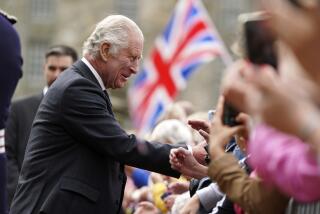The many faces of Richard III

Who was Richard III?
We’ve got an idea of what he looked like thanks to a new 3-D reconstruction of his head, made after the discovery of his skull, along with the rest of his skeleton, under a parking lot in Leicester, England.
But what kind of person he was remains in dispute. Was the king, who died at 32 in the Battle of Bosworth Field in 1485, an emerging democrat and saintly protector? Or was he the “poisonous bunch-backed toad” of Shakespeare’s “Richard III,” an ogre who murdered his brother’s sons and stole the crown, making him the most notorious usurper in English history?
PHOTOS: Remains of King Richard III
The truth is, we know little about him, which leaves plenty of room for projecting ideas and emotions. Philippa Langley, a screenwriter and the secretary of the Scottish branch of the Richard III Society, who agitated for the excavation of the Leicester parking lot, is firmly in the defend-Richard camp. At the unveiling of the model of the king’s head, she insisted to an interviewer: “It doesn’t look like the face of a tyrant. I’m sorry but it doesn’t. He’s very handsome.”
Then there’s Ishaan Tharoor at Time magazine, who calls Richard “one of history’s losers.”
Contemporaneous accounts aren’t of much help in settling the dispute, as nearly all were propaganda. Chronicler John Rous wrote this about Richard during his lifetime: “The most mighty Prince Richard ... all avarice set aside ruled his subjects in his realm full commendably.”
But by the time Rous wrote his “History of the Kings of England,” years after Richard’s death, the historian’s views had changed. He described Richard as a monster, born with teeth and hair to his shoulders, who stayed two years in his mother’s womb.
What can we say for certain about Richard III? The last king from the House of York was brave, a capable soldier despite his scoliosis. He was the last English king to lead his men in battle, wearing his crown, though he knew he would be a target. He married a childhood friend and seems to have been faithful to her. We know that he never tried to make his illegitimate son John — born before his marriage — heir to the throne after his legitimate son died. We also know that he named his nephew Edward Warwick his heir instead — the same Edward Warwick whom Henry VII later murdered. Richard was deeply religious and carried his book of hours into battle with him.
Some of Richard’s supporters claim that he invented bail. This isn’t true, though his Parliament, to prevent sheriffs from rushing men into prison and extorting money for their release, extended the right to grant bail to justices of the peace. Under Richard, benevolences — the extortion by the crown of money from the nobility — were outlawed, and laws were printed in English so that more people could understand them. These things may not be many, but they tell us something.
We don’t know for certain what happened to his nephews, who were in line for the throne ahead of him. He may have had them executed at the Tower of London. But there’s no definitive proof, and his successor Henry VII never directly accused him of their murder.
Still, Richard certainly had blood on his hands. Initially, he executed five men he believed to have plotted against him: William Hastings, Anthony Rivers, Thomas Vaughan, Richard Haute and the younger son of Edward IV’s wife, Richard Grey. According to 19th century historian Clements R. Markham, 11 other rebels were tried and executed after a failed rebellion in 1483. Two others were executed for treason the following year. That’s a grand total of at least 18.
Richard also spared many people, though, including Bishop Stanley Morton, who betrayed him in two conspiracies, and Hastings’ mistress, Jane Shore, a possible co-conspirator with Hastings.
Richard did not make war against bishops and women. But the Tudors who succeeded him did. Henry VII and his son, Henry VIII, killed almost all the remaining Yorkists, including 70-year-old Countess Margaret Pole, who forced the executioner to pursue her around the chopping block as she refused to “give them her head.”
The English chronicler Raphael Holinshed, in 1580, estimated the number of Henry VIII’s victims at 72,000. Henry destroyed abbeys and monasteries, confiscating their wealth and slaughtering monks for heresy. He executed Lutherans too. His Catholic daughter, Queen Mary, killed almost 300 Protestants and about 20 other political opponents, men and women alike. Protestant Queen Elizabeth killed at least 30 Catholics — some sources say thousands — and executed, in addition, 42 other people. Henry and Elizabeth also, according to writer G.J. Meyer, legitimized torture as a political tool.
Whatever Richard III was, he was not a Tudor, and any sins at his door seem wan by comparison.
Before the Battle of Bosworth Field, according to an account by Morris McGhee, former chair of the American branch of the Richard III Society, Richard marched his men up the roads “like a decent Englishman,” while Henry Tudor ordered his men through the fields of ripening wheat, destroying the crop and causing a famine.
Perhaps, knowing any summation must be incomplete, we can leave the final word to Bishop Thomas Langton, who wrote in a private letter about Richard III in August 1483:
“He contents the people where he goes best that ever did prince; for many a poor man that hath suffered wrong many days have been relieved and helped by him.... God has sent him to us for the weal of us all.”
Wendy Orent is a Richard III enthusiast and the author of “Plague: The Mysterious Past and Terrifying Future of the World’s Most Dangerous Disease.”
More to Read
A cure for the common opinion
Get thought-provoking perspectives with our weekly newsletter.
You may occasionally receive promotional content from the Los Angeles Times.










